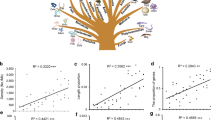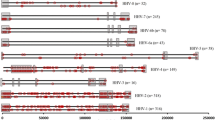Abstract
In silico comparative analysis of nuclear and mitochondrial genomes of vertebrates and yeast revealed the distribution of nucleotide sequences that are predisposed to the formation of noncanonical DNA structures, G-quadruplexes, which are closely related to the regulation of expression of a number of genes and are abundant within the hot-spots of double-strand DNA breaks. The obtained data indicate the preferred localization of potential quadruplexes in the noncoding DNA sequences, their evolutionary conservation, and the existence of homology between them in the mitochondrial and nuclear genomes. The relationship between quadruplexes, Pif1 helicase, and genomic instability is discussed.
Similar content being viewed by others
References
Greaves M., Maley C.C. 2012. Clonal evolution in cancer. Nature. 481, 306–313.
Lord C.J., Ashworth A. 2012. The DNA damage response and cancer therapy. Nature. 481, 287–294.
Kadapadi V.K., Nambiar M., Raghavan S.C. 2012. Potential G-quadruplex formation at breakpoint regions of chromosomal translocations in cancer may explain their fragility. Genomics. 100, 72–80.
Raghavan S.C., Lieber M.R. 2007. DNA structure and human diseases. Front. Biosci. 12, 4402–4408.
Raghavan S.C., Lieber M.R. 2006. DNA structures at chromosomal translocation sites. BioEssays. 28, 480–494.
Wang G., Vasquez K.M. 2006. Non-B DNA structureinduced genetic instability. Mutat. Res. 598, 103–119.
Collie G.W., Parkinson G.N. 2011. The application of DNA and RNA G-quadruplexes to therapeutic medicines. Chem. Soc. Rev. 40, 5867–5892.
Nambiar M., Raghavan S.C. 2011. How does DNA break during chromosomal translocations? Nucleic Acids Res. 39, 5813–5825.
Nambiar M., Goldsmith G., Moorthy B.T., Lieber M.R., Joshi M.V., Choudhary B., Hosur R.V., Raghavan S.C. 2011. Formation of a G-quadruplex at the BCL2 major breakpoint region of the t(14;18) translocation in follicular lymphoma. Nucleic Acids Res. 39, 936–948.
Ju Y.S., Lee W.-C., Shin J.-Y., Lee S., Bleazard T., et al. 2012. A transforming KIF5B and RET gene fusion in lung adenocarcinoma revealed from whole-genome and transcriptome sequencing. Genome Res. 22, 436–445.
Fekete A., Kenesi E., Hunyadi-Gulyas E., Durgo H., Berko B., et al. 2012. The guanine-quadruplex structure in the human c-myc gene’s promoter is converted into B-DNA form by the human poly(ADP-ribose)polymerase-1.1. PLoS ONE. 7(8), e42690.
Tsai Y.-C., Qi H., Lin C.-P., Lin R.-K., Kerrigan J.E., Rzuczek S.G., LaVoie E.J., Rice J.E., Pilch D.S., Lyu Y.L., Liu L.F. 2009. A G-quadruplex stabilizer induces M-phase cell cycle arrest. J. Biol. Chemistry. 284, 22535–22543.
Marcel V., Tran P.L.T., Sagne C., Martel-Planche G., Vaslin L., Teulade-Fichou M.-P., Hall J., Mergny J.-L., Hainaut P., van Dyck E. 2011. G-quadruplex structures in TP53 intron 3: Role in alternative splicing and in production of p53 mRNA isoforms. Carcinogenesis. 32, 271–278.
Capra J.A., Paeschke K., Singh M., Zakian V.A. 2010. G-Quadruplex DNA sequences are evolutionarily conserved and associated with distinct genomic features in Saccharomyces cerevisiae. PLoS Comput. Biol. 6, 1–13.
D’Onorio de Meo P., D’Antonio M., Griggio F., Lupi R., Borsani M., Pavesi G., Castrignano’ T., Pesole G., J. Nucleic Acids. 2010, 6 Gissi C. 2012. Mito-Zoa 2.0: A database resource and search tools for comparative and evolutionary analyses of mitochondrial genomes in Metazoa. Nucleic Acids Res. (Database issue). 40(D1), D1168–D1172.
Wong H.M., Stegle O., Rodgers S., Huppert J.L. 2010. A toolbox for predicting G-quadruplex formation and stability. J. Nucleic Acids. 2010, 6 P; doi 10.4061/2010/564946
Du Z., Zhao Y., Li Ning. 2009. Genome-side colonization of gene regulatory elements by G4 DNA motifs. Nucleic Acids Res. 37, 6784–6798.
Chatre L., Ricchetti M. 2011. Nuclear mitochondrial DNA activates replication in Saccharomyces cerevisiae. PLoS ONE. 6 (3), e17235.
Paeschke K., Capra J.A., Zakian V.A. 2011. DNA replication through G-quadruplex motifs is promoted by the Saccharomyces cerevisiae Pif1 DNA helicase. Cell. 145, 678–691.
de Souza-Pinto N. C., Aamann M.D., Kulikowicz T., Stevnsner T.V., Bohr V.A. 2010. Mitochondrial helicases and mitochondrial genome maintenance. Mech. Ageing Dev. 131, 503–510.
Uringa E.-J., Youds J.L., Lisaingo K., Lansdorp P.M., Boulton S.J. 2011. RTEL1: An essential helicase for telomere maintenance and the regulation of homologous recombination. Nucleic Acids Res. 39, 1647–1655.
Thomas J., Schaack S., Pritham E.J. 2010. Pervasive horizontal transfer of rolling-circle transposons among animals. Genome Biol. Evol. 2, 656–664.
Yang L., Bennetze J.L. 2009. Structure-based discovery and description of plant and animal Helitrons. Proc. Natl. Acad. Sci. U. S. A. 106. 12832–12837.
Kapitonov V.V., Jurka J. 2001. Rolling-circle transposons in eukaryotes. Proc. Natl. Acad. Sci. U. S. A. 98, 8714–8719.
Author information
Authors and Affiliations
Corresponding author
Additional information
Original Russian Text © B.L. Zybailov, M.D. Sherpa, G.V. Glazko, K.D. Raney, V.I. Glazko, 2013, published in Molekulyarnaya Biologiya, 2013, Vol. 47, No. 2, pp. 224–231.
Rights and permissions
About this article
Cite this article
Zybailov, B.L., Sherpa, M.D., Glazko, G.V. et al. G4-quadruplexes and genome instability. Mol Biol 47, 197–204 (2013). https://doi.org/10.1134/S0026893313020180
Received:
Accepted:
Published:
Issue Date:
DOI: https://doi.org/10.1134/S0026893313020180




